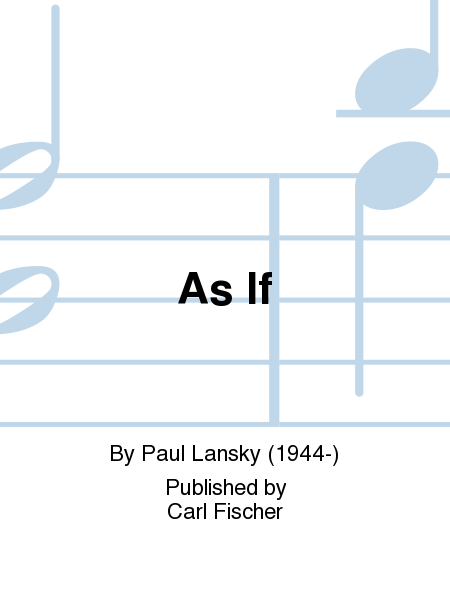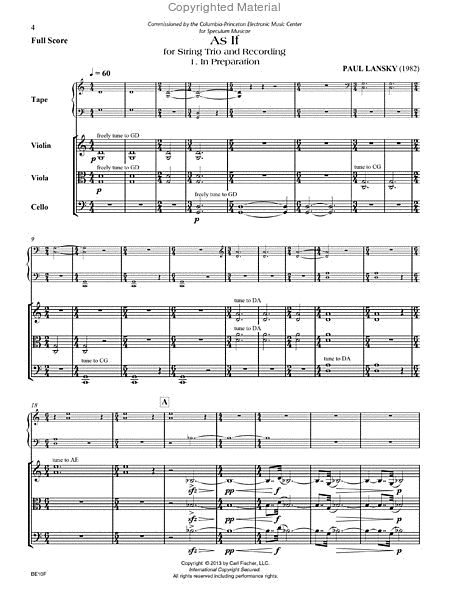Details
Description
SKU: CF.BE10
Composed by Paul Lansky. Set of Score and Parts. With Standard notation. 32+18+18+18 pages. Duration 19 minutes. Carl Fischer Music #BE10. Published by Carl Fischer Music (CF.BE10).ISBN 9780825891168. UPC: 798408091163. Score. 8.5x11, Pts. 9x12 inches. Key: G major.
As If is Paul Lansky at the genesis of his computer music powers. Here he explores the relationship between pre-recorded and live performers, forcing a re-examination of the concepts of both composition and performance. Lansky worked with an early IBM computer (1981) for As If, a far cry from the powerful computers and complex algorithms he would later create. Duration: 19'37.
Commissioned by the Princeton-Columbia Electronic Music Center for SpeculumMusicae in 1981.The first movement, In Preparation, is a study in tuning and intonation and isbased on the open strings in perfectly tuned fifths, with the violin’s D stringtuned 294 hertz. The first moments of the piece provide opportunity to tuneto the tape part. (This tuning probably differs imperceptibly from a temperedtuning since the E string of the violin is only 1/33 of a semitone sharper then ina tempered system and the C strings of the viola and ‘cello 1/33 of a semitoneflatter.) Most subsequent pitches in the movement are either the open stringsor major and minor thirds above and below the open strings. The minor thirdswill be slightly sharp with respect to equal tempered tuning about 15 cents or1/6 of a semitone and the major thirds will be slightly flat about 14 cents, or oneseventh of a semitone. Listen to the tape part as a guide. All harmonics in thismovement are to be played as natural harmonics and open strings are to be usedwhenever possible.In the second movement, At a Distance, the tape part largely doubles selectedpitches in the string parts and should be thought of as a backdrop rather thencounterpart. In this and the remaining movements equal tempered tuning is usedthough it will probably not be necessary to retune the instruments for this reasonalone.The third movement, In Practice, is a study in modes of performance particularlywith respect to rhythmic rigidity and flexibility. While the tape part may seemto bend and sway a great deal, the string parts are to be played with as muchrhythmic precision as possible. At many points it may be necessary to delay oranticipate beats in order to coincide with the arrival of beats in the tape part,though in general the quarter equals 120 is accurate.In the fourth movement, In Distinction, different kinds of musical conceptions arecounter-pointed and counter-posed. Here the beat is quite accurate although thenotation of the synthetic saxophone part is only approximate.All the tape parts are based on computer reprocessed violin except for parts ofthe fourth movement in which synthetic saxophone is used. The tape part wassynthesized on the IBM 3033 and 3081 computers at Princeton University andconverted at the Winham Laboratory. The violin source was performed by CyrusStevens.


 Share
Share